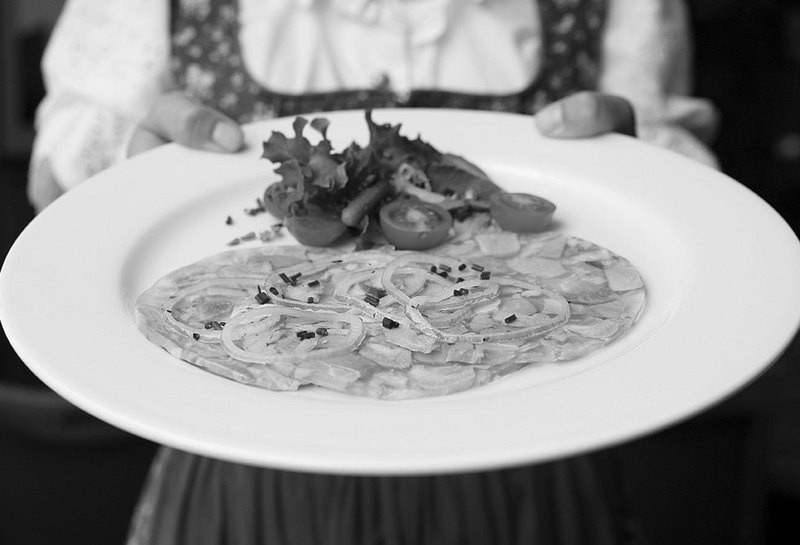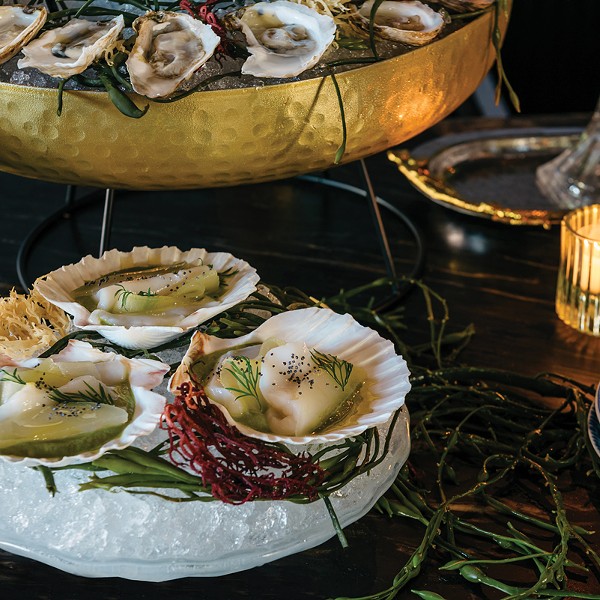
I’m an adventurous eater, but when I go out, I usually stay within a fairly limited range of dishes from the handful of restaurants that I patronize on a regular basis. (Admittedly, this includes the entire phalanx of French bistro fare, from frog’s legs to escargot, as well as the head-to-tail tapas of Rich Reeve at Elephant, which I wrote about in our May issue.) At home, I’m much the same but even more so: I try and cook seasonally appropriate dishes, quickly and simply. My assumption, based on purely anecdotal evidence, is that most of us are like this. We have a few go-to preparations in our repertoire, and we cleave fairly closely to them or variations of them.
What we eat is many things—life-sustaining nutrient intake dressed up as ritual; status symbol; exercise in nostalgia; principal way most of us come into contact with the life-cycle of the planet; and the celebration of our dominion, as a species, over the planet. But it’s also a choice we make every day, multiple times a day, about what we put into our bodies. Not surprisingly, we want to ingest food that is familiar to us, not some off-putting assemblage of ingredients that looks/smells/tastes outside of the range of what we have defined as suitable eats. We want to be comforted. We want comfort food.
Ask 10 people what their notion of comfort is, however, and you’re likely to get 10 different answers. Steak and potatoes for one, grilled cheese and tomato soup for another, and quinoa and seitan for someone else. Our collective sense of what is exotic is in an evolutionary process as well. The past few decades have witnessed the proliferation of ethnic eateries (think Greek and Jamaican as well as Chinese and Italian) and inventive chefs working in the Hudson Valley. According to John Novi, when he opened the Depuy Canal House in High Falls in 1969, his was the only restaurant in the region serving duck that wasn’t in the classical continental l’orange style; instead, Novi made his own confit and also served the sliced duck breast, a bold move at the time. (Duck, sans the l’orange, is now de rigueur in the untold—but not all undistinguished—restaurants billing themselves as New American, the current epitome of high-end comfort food.) Even the august Depuy Canal House is furthering the trend toward greater culinary diversity, with a gourmet pizza shop and sushi bar in its cellar. And to his credit, Novi is still generating interesting ideas that turn comfort food on its head—he recently created a five-course meal around sweetbreads. Sweetbreads being, of course, the thymus gland of lamb, cows, or pigs.
In June, I set out to find fare like Novi’s sweetbreads, dishes that challenged me to eat outside my normal limits, food that pushed me outside of my comfort zone and into unfamiliar culinary territory. I hesitate to use the word exotic to describe what I was looking for, as the word is freighted with subjectivity. A recent restaurant review in a local newspaper, for instance, described a local Indian restaurant as a “solid choice for exotic fare.” But for me, who has been eating Indian food on a regular basis for 15 years, samosas are to egg rolls as lo mein is to linguine. Indian food is no more exotic than pizza, it’s just what’s for dinner. What I was looking for was farther afield than sushi, jambalaya, or escargot. Call it “un-comfort” food, the preparations 180 degrees from what I would normally eat. It started with head cheese tacos and ended with venison kielbasa topped with kim chee. Along the way I was delighted, full to bursting at many points, and never once disgusted.
HEAD TO HEAD
Living in Kingston, I eat at El Danzante quite a bit. El Danzante is an unprepossessing Mexican place on upper Broadway, with glass-topped tables and a bizarre grotto bar framed in stucco, that serves equal numbers of Mexican immigrants and gringos. I usually play it safe there, ordering either fried pork chops or a chorizo chimichanga, perhaps with a side of guacamole. The chimichangas are crisp, the chorizo is spicy, the guacamole is not whipped into a mousse—it’s solid and chunky. The chef at El Danzante isn’t aiming to win a James Beard award, but the food is filling and comforting.
For the un-comfort food project, I ordered a couple of tacos that I had studiously avoided previously. The first was cabeza de puerco—head cheese, or boiled head of pig with herbs and spices; the second was lengua al vapor—steamed beef tongue. They were served on soft double corn tortillas with onions and cilantro. Curiously, both tasted quite similar, the tiny shards of meat contained in each overpowered by the other ingredients and the tortillas. Not at all the shock to the taste buds I was expecting, just slightly chewier in texture than shredded beef or pork. The tacos were perfectly fine, but not interesting enough to keep me from ordering chimichangas and pork chops next time at El Danzante.
The Mountain Brauhaus, the standard bearer for German cuisine in the region, was my next stop. Located at the foot of the Shawangunk Ridge, the Brauhaus is always packed, with waitresses in dirndls ushering trays of sauerbraten and wiener schnitzel to and fro while diners drink mugs of Spaten. As a fan of stick-to-your-ribs cuisine, a meal at the Brauhaus is a sentimental journey for me, taking me back to my grandmother’s beef rouladen and German potato salad. On most trips, I’ll order the pot roast or the bratwurst, with sides of red cabbage and potato pancakes. The Brauhaus’s reputation for flavorful, generously portioned German food is well deserved.
On a Father’s Day visit, I ordered the oddest thing on the menu—sulze. Served as an appetizer, sulze is the German version of head cheese. It’s served luncheon-meat style, a few disks of gelatin spotted with chunks of pink meat. Visually, it’s disconcerting to see bits of meat suspended in a clear gel. But that doesn’t detract from its fascinating taste. As sulze is made with pickles and vinegar, it has a tang that snaps in concordance with the snap of the sulze’s texture. The taste of the meat? Like boiled meat with pickles and vinegar, corned beef’s bite-sized cousin. The Brauhaus’s sulze was no revelation, but it was tasty and respectable for what it was, well made un-comfort food.
GONE TO THE DOGS
A dedicated carnivore, I don’t traffic much in protein substitutes—tofu, seitan, and the like. For instance, if I’m going to eat a hot dog, I’ll buy a couple of franks from the guy with a cart around the corner from my office, and not ask too many questions about the provenance of the meat. Sauerkraut and onions hides many an imperfection. So it seemed fitting, un-comfortwise, to venture to Soul Dog on Main Street in Poughkeepsie and try their veggie dogs on gluten-free buns. Opened in 2004 by a couple who wanted to create a place where people with dietary restrictions and food allergies could go for comfort food, Soul Dog offers about 25 toppings, ranging from old standbys like onions in red sauce to marsala mushrooms, guacamole, and vegetarian chili. In addition to veggie dogs, they also serve Sabrett all beef dogs and Applegate chicken dogs. I ordered one of each, all on gluten-free buns, along with a Redbridge, a gluten-free beer made from sorghum by Anheuser-Busch.
The Redbridge was a bit disappointing, in an odd way. It was light-bodied like a pilsner, but also contained heavier, syrupy notes due to the sorghum that crept in every few sips. The dogs, however, were a delight. On my veggie dog, I ordered the day’s special topping, the “Jackie Chan,” peanut sauce and jalapenos. The chicken I had with roasted poblano pepper salsa. The Sabrett was served with “Soul sauce,” the house hot sauce/salsa. The veggie dog itself was bland, but that allowed it to be a blank slate for the spicy peanut sauce and pinpricks of heat in the diced jalapenos. The poblano pepper salsa was a winner, chunky and with a smoldering heat that knew how to play nice with the chicken dog. The true revelation at Soul Dog was the gluten-free buns, made with chick pea flour and lightly toasted. Having become accustomed to bleached white flour buns, usually primed for soggy disintegration under any overly moist topping, the chick pea flour buns had an actual flavor to them (the subtlest hint of toasted chick peas), and didn’t taste like they sprang fully formed from the Wonder Bread machine. Soul Dog is now my go-to hot dog stand.
BEST FOOT FORWARD
Next door to Soul Dog, at the West Indies Jamaican Restaurant, I picked up the most un-comfortable food I encountered in my travels—cow foot. A take-out joint patronized solely by Jamaican-accented folks on the day I stopped, West Indies Jamaican Restaurant had a sign on its steam table that read “Cow Foot.” When the woman behind the counter asked me what I wanted, I asked to see the cow foot. She beckoned me over to view a mass of bone and cartilage in an oily broth. I ordered the medium size for $8, served on a bed of rice and beans and reheated-from-frozen vegetable medley.
Cow foot is a traditional Jamaican stew, basically turning portions of an animal that those who could afford better cuts didn’t want, and making it palatable by a long braise. The sight alone of a mound of cross-sectioned foot bones on rice will probably put a number of people off, but cow foot looks a lot like shank cut for osso buco. The texture is more sinewy than osso buco and the layer surrounding the actual “meat” runs the spectrum between fatty and gelatinous. Fueled mostly by salt and pepper, the flavor spectrum of cow foot is a bit narrow, never revealing than its protein base and added condiments. Like skydiving, cow foot is something everyone should try once, after the initial foray, I leave it to the individual to decide.
MOLECULAR GASTRONOMY
My final pit stop in my culinary road rally was at DaBa in Hudson, a vision of Brooklyn hipsterdom transplanted to Hudson. And the food is just as good as you would expect from a New York City restaurant trying to push its cuisine in an adventurous direction. On the two occasions I’ve eaten at DaBa, my companion and I chose the tasting menu, and both times I was caught off-guard not only by the flavor pairings—wild boar paté with a gin-and-tonic glaze, for instance—but also by the inventive textures and chemical compositions of the ingredients. On my most recent visit, I was served a “Crispy Tuna Tartare.” The presentation, on a thin white plate with three serving hollows, was one part sautéed scallop, one part shards of tuna tartare with tiny enoki mushrooms surrounded by a thin ring of wonton crisp, and one part cucumber vinaigrette. But here’s the twist, or at least part of it—the vinaigrette ain’t wet, it’s set as a gelatin, and as subtle an accompaniment to seafood as you could hope for. The fun at DaBa is seeing where chef Ola Svedman might take you out of your comfort zone next.
Oh, and the venison kielbasa with kim chee? That was just something I grilled up at home, the kielbasa given to me by my neighbor. I added the sauerkraut-esque kim chee from a jar I had in the fridge. Gamey, spicy venison sausage paired with piquant fermented cabbage was a tasty and insightful bookend to my adventure. After three weeks of scratching for the truffles of offbeat morsels at every crossroads, it was comforting to realize that not all culinary adventures need take me any further than my back patio.
There are, no doubt, many more restaurants in the Hudson Valley serving food that is off the beaten path. (There have, in fact, been reported sightings of brain quesadilla in Wappingers Falls and confirmation of a Peruvian tripe dish at Machu Picchu in Newburgh!) If you have any suggestions on where to find food that takes the jaded palate out of its comfort zone, please post a comment to this article at www.chronogram.com or e-mail me at bmahoney@chronogram. I plan on posting a follow-up piece to the website later this month.

















